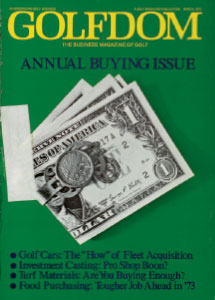Golfdom Files Extended: Turf materials: Are you buying enough?
 El Nino has caused havoc on golf courses and specifically dropping buckets of rain in the Carolinas and Texas. A similar phenomenon happened in 1972 with rainfall in different pockets of the country falling at well above the long-term averages.
El Nino has caused havoc on golf courses and specifically dropping buckets of rain in the Carolinas and Texas. A similar phenomenon happened in 1972 with rainfall in different pockets of the country falling at well above the long-term averages.
In response to the record precipitation Golfdom published an article in the March 1973 magazine that outlined what superintendents could expect once the spring hit and the snow started to melt. The condensed list compiled by James A. Beard, Ph.D., was printed in a recent edition of Golfdom and we present the rest as an Online Exclusive.
Last year’s excessive rain and flooding will turf problems for many superintendents this year. Purchases and personnel should be prepared to meet this extra burden.
By James A. Beard, Ph.D.
A review of the United States Weather Bureau records reveals that most of the cool humid and warm humid climatic regions of the United States experienced precipitation levels well above the long-term averages. The large scale flooding localized standing water in depressional areas during 1972 are now history, but a number of hidden problems remain to be faced. The excessively wet soil conditions have created a number of problems that golf course officials and superintendents must take into consideration in planning their 1973 maintenance program.
Soil compaction
Excessively wet soil conditions during 1972 have most probably resulted in greater soil compaction under turfs than would normally be experienced during a growing season. Wet soils approaching field capacity are more prone to compaction than drier soils. This means that deep-soil cultivation, in the form of coring or slicing, will have to be increased during 1973. Preferably this should be accomplished during ping. Also, the fold course maintenance budget should be adjusted upward to cover the added costs of these cultivation operations. Greater problems can be anticipated in maintaining adequate turfgrass quality and density during the 1973 midsummer stress period, if the increased soil compaction is not corrected.
Winter disease
Wet soil conditions entering the winter dormancy period usually favor increased disease development on turfs. Spring dead spot on bermudagrass turfs is frequently a greater problem under wet soil conditions.
The two snow mold diseases, Typhula blight and Fusarium patch, also are enhanced by wet soil conditions during winter periods when the soil is not frozen. This increased winter disease activity means that snow-mold fungicide application rates, which would normally be effective under drier conditions, may fail to give adequate control. Thus, golf courses that attempt to economize by using marginally low fungicide rates may suffer above-normal damage from snow mold diseases.
Low-temperature kill
Winter injury caused by direct low temperature kill may be greater during the 1972-1973 winter. The bermudagrasses and annual bluegrass are particularly prone to this type of kill. Standing water at the soil surface, which increases the water content in the turfgrass tissues, particularly the crowns, will greatly increase the proneness to direct low-temperature kill. If the wet soil conditions persist throughout the winter period and the proper combination of low temperatures and frequent freezing and thawing occur, a significant increase in turf damage caused by low-temperature kill can be expected.
Not much can be done at this time to minimize this problem. Golf courses that have invested in improving their drainage systems in the form of proper surface contours and the installation of the tiles drains, French drains and catch basins, will most probably have less winter injury problems should winter low temperature kill occur.
Restricted rooting
The excessively wet conditions during the 1972 growing season resulted in many golf course turfs entering the winter dormancy period with a drastically reduced root system. This means that the overall health and vigor of the turf is below the desired standard. If the winter season has been characterized by a lack of snow cover plus increased atmospheric desiccation and soil drought, the turf also will be more prone to injury from winter desiccation. Golf course personnel should be alert to this possibility and should initiate procedures to minimize the degree of winter moisture stress should this condition develop.
1973 fertilization program
Excessive rainfall during 1972 has increased the degree of soil leaching, particularly nitrogen. This means somewhat higher nitrogen fertilization rates will have to be utilized to correct the situation. Most frequently, this increased nitrogen fertilization requirement due to excessive soil leaching does not become a problem until the following year. Thus, golf course maintenance personnel should be alert to this potential problem. Nitrogen fertilization levels should be adjusted somewhat higher if the normal turfgrass color, density and growth rate cannot be maintained with the nitrogen fertility levels utilized in previous years. The 1973 maintenance budget should also be adjusted to cover this eventuality.
Spring green-up
Spring is a period of great anticipation for the golfer. He wants the golf course to green-up and reaches optimum playing conditions as rapidly as possible. This response is controlled primarily by soil temperature. The earlier in the spring that the soil warms up, the earlier that turfgrass spring green-up and growth occur. The rate at which soils warm up is strongly affected by the soil moisture level. Wet soils are much slower to warm up than drier soils due to the higher specific heat of water. Thus, if the soils are excessively wet during the spring period, the turfgrass maintenance personnel should not get overly concerned and attempt to stimulate spring green-up and growth by applying nitrogen fertilizer. Nitrogen fertilization does stimulate turfs to break dormancy and green-up earlier in the spring, but this response will not overcome cold soil conditions caused by too much soil moisture. The application of excessive nitrogen fertilizer under this condition will only result in an explosion in turfgrass growth at a later date that can be detrimental to the turf in the long run.
A Final Note. The six potential problems listed previously may or may not occur. The soil compaction and nitrogen leaching problems will most probably occur. Whether or not the other four problems occur depends on the specific weather conditions during the winter and spring period and will most probably vary from region to region across the country. This discussion was presented in order that appropriate contingency plans can be developed in case one of more of these problems do occur.
Finally, a number of these potential problems can be avoided if an adequate surface and sub-surface drainage has been developed. If this is not the case, an attempt should be made to map those areas where excessive soil moisture and flooding have occurred. Plans should then be developed to correct the condition. The plans should include a time table for accomplishing the projects as well as an adequate budget to cover such special projects.









